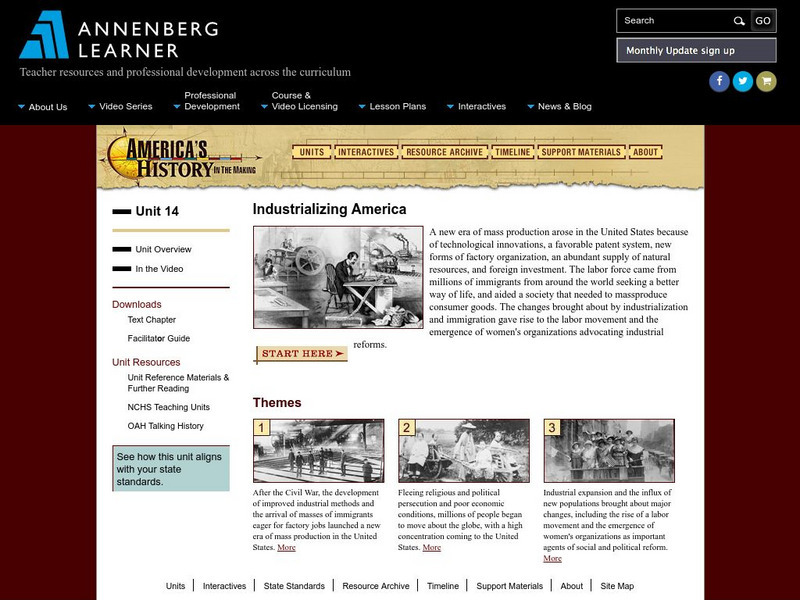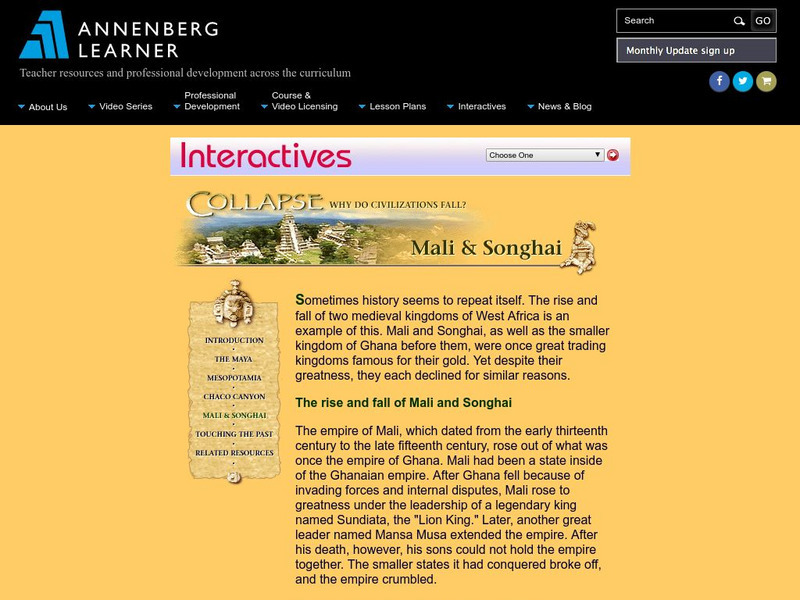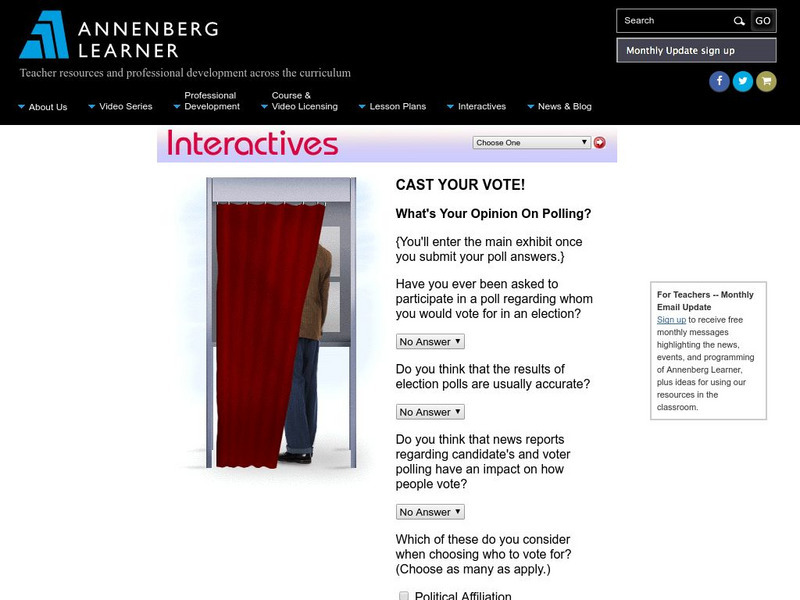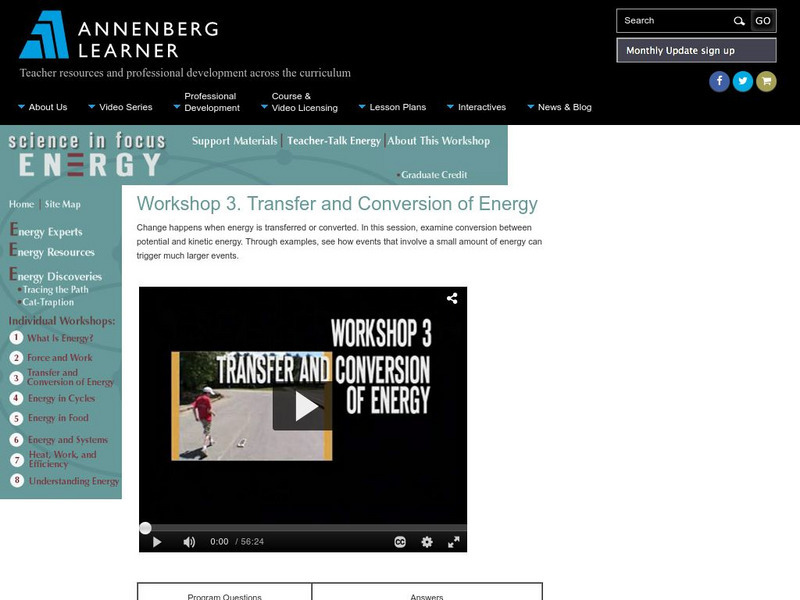Annenberg Foundation
Annenberg Learner: America's History in the Making: Industrializing America
Comprehensive teaching unit that explores the "second industrial revolution" and the mass production of consumer goods. This, in turn, caused an increase in the labor force and immigration. Learn how these changes brought about the start...
Annenberg Foundation
Annenberg Learner: America's History in the Making: Contested Territories
This site highlights the westward expansion of settlers in North America and the effects this expansion had on Native Americans between the Revolutionary and Civil Wars.
Annenberg Foundation
Annenberg Learner: Collapse: Mali and Songhai: Growth and Decline
Engrossing site that explores the settlement and decline of Mali and Songhai. The site examines the city of Timbuktu and the impact of years of turmoil and conquest on the settlement.
Annenberg Foundation
Annenberg Learner: Renaissance: Become a Spice Trader
This site provides detailed information about the adventures of becoming a spice trader. The site allows the researcher to experience an exhibit as a "traveler" by clicking on various links.
Annenberg Foundation
Annenberg Learner: Renaissance: Exploration and Trade
Detailed introduction on exploration and trade during the Renaissance. Provides an overview of the tools created during the Middle Ages that made such travels by sea possible as well as insight into the types of goods traders sought in...
Annenberg Foundation
Annenberg Learner: Interactives: Cast Your Vote!
Upper elementary, middle, and high school students can use this exhibit to get an understanding of how polls and elections are conducted. The discussion includes random samples, margins of error, and other concepts related to statistics.
Annenberg Foundation
Annenberg Learner: Against All Odds: What Is Statistics?
A video presentation covering the history and evolution of statistics, as well as this area of math's link to our everyday world. View simple examples, including the application of statistics in the business world. [28:36]
Annenberg Foundation
Annenberg Learner: Earth and Space Science: Earth's Solid Membrane: Soil
Material to launch exploration of Earth's soil and its important role. View a one-hour video, accompanied by details on soil horizons and soil formation, and ideas for bringing this topic into the classroom.
Annenberg Foundation
Annenberg Learner: Bridging World History: History and Memory
Are history and memory different? Peruse the various resources this unit provides for the way we view, know, and relate history to our family, our friends, and the world.
Annenberg Foundation
Annenberg Learner: Democracy in America: Civil Rights: Demanding Equality
This unit embraces those individuals who have brought change to the United States in both social and political equality through a Video on Demand, activities, and other enlightening resources.
Annenberg Foundation
Annenberg Learner: Dynamic Earth Interactives
Interactive tutorials on plate tectonics, plates and boundaries, and the Earth's structure convey the dynamism of geologic processes, such as earthquakes and volcanoes. Takes a multidimensional approach to coverage of basic geologic...
Annenberg Foundation
Annenberg Learner: The Human Brain
Explore the human brain, and the role it plays in the nervous system. Students learn about the three main parts of the brain and each of their functions.
Annenberg Foundation
Annenberg Learner: Making a Stem and Leaf Plot
A line plot may not be a useful graph for investigating variation so we must come up with a new representation based on groups of data. Construct a stem and leaf plot from a set of 26 data values.
Annenberg Foundation
Annenberg Learner: Story Elements Using Cinderella
Listen to an explanation of the story elements in Cinderella including exposition, characters, setting, sequence, conflict, climax, and resolution.
Annenberg Foundation
Annenberg Learner: Arbiter
Determine your standards (logic, creativity, structure, etc.) when assessing student writing. Evaluate three essays using an analytic or holistic rubric and see how your standards compare with your peers.
Annenberg Foundation
Annenberg Learner: Grades 11 12 Spelling Bee
Read and listen to stories with some words missing. Click appropriate grade level tab. Fill in the missing words, see how many words you spelled correctly, and get corrections for the ones you missed. L.11-12.2 Cap/Punc/Spell
Annenberg Foundation
Annenberg Learner: Primary Sources: The Lowell System
An hour-long professional development video on teaching how the Lowell System was a departure from traditional labor practices. Features experienced classroom teachers. Materials and a complete lesson plan are also provided.
Annenberg Foundation
Annenberg Learner: Invitation to World Literature
Multimedia course focuses on thirteen literary classics from many different times and many different cultures. Each lesson centers on a half-hour video offering multiple perspectives on a particular work. Read excerpts from each work and...
Annenberg Foundation
Annenberg Learner: Problem Based Learning (Pbl) and Socratic Questioning
Part of a teacher workshop called "Making Civics Real," this section explains how to use questioning, especially Socratic questioning, in problem-based learning. For those not used to employing the Socratic method, the "Taxonomy of...
Annenberg Foundation
Annenberg Learner: Habitable Planet: A Systems Approach to Environmental Science
Interdisciplinary multimedia course, in thirteen units, on environmental science. Each unit encompasses a thirty-minute video, an accompanying textbook chapter, and an array of visuals and animations. With five interactive labs, a...
Annenberg Foundation
Annenberg Learner: Science in Focus Energy: What Is Energy?
A video workshop looking at the concept of energy. Discussions include energy as it is used in everyday language to the complex scientific meaning of energy. Presents common student misconceptions, history, and the importance of energy...
Annenberg Foundation
Annenberg Learner: Science in Focus: Energy: Energy in Food
A video workshop examining how the Sun provides energy for all living things beginning with the process of photosynthesis. Presents current scientific thinking about energy transfer through the food chain as well as ways to deal with...
Annenberg Foundation
Annenberg Learner: Teaching Geography: Global Economy
Take a close look into two vastly different global regions and delve into the effects the environment has on the respective economies. A video presents areas in Southeast Asia pertaining to the global economy and areas in the United...
Annenberg Foundation
Annenberg Learner: Science in Focus: Energy: Transfer and Conversion of Energy
Change happens when energy is transferred or converted. Included with the teaching unit, is a sixty-minute video that examines the conversion between potential and kinetic energy.














